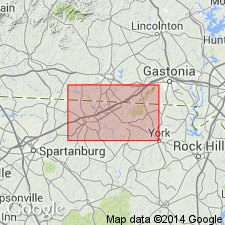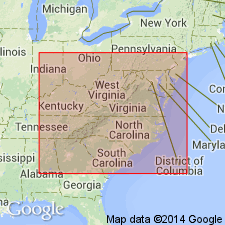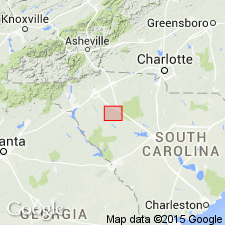
- Usage in publication:
-
- Battleground schist*
- Modifications:
-
- Original reference
- Dominant lithology:
-
- Schist
- Conglomerate
- AAPG geologic province:
-
- Piedmont-Blue Ridge province
Summary:
Battleground schist. Chiefly white, gray, bluish, bluish black, and mottle white and bluish sericite schists, with, at top, a manganese schist member nearly 300 feet thick; several very persistent beds of conglomerate are present. Thickness 1,000 to possibly 2,500 feet. Unconformably underlies Kings Mountain quartzite and unconformably overlies Archean rocks. Assigned to Algonkian.
[Named from exposures on Kings Mountain Battleground, York Co., northwestern SC.]
Source: US geologic names lexicon (USGS Bull. 896, p. 126).

- Usage in publication:
-
- Battleground schist*
- Modifications:
-
- Incidental mention
- AAPG geologic province:
-
- Piedmont-Blue Ridge province
Summary:
Pg. 204, 206. Battleground schist. Mentioned in discussion of mica deposits in Shelby-Hickory district, North Carolina. [Age is Ordovician to Mississippian.]
Source: US geologic names lexicon (USGS Bull. 1200, p. 239).

- Usage in publication:
-
- Battleground schist
- Modifications:
-
- Areal extent
- AAPG geologic province:
-
- Piedmont-Blue Ridge province
Summary:
Pg. 27-30, fig. 1. Battleground schist described in Kings Mountain belt, Laurens County, South Carolina. Age is Precambrian(?) or Paleozoic(?). [GNC remark (ca. 1960, US geologic names lexicon, USGS Bull. 1200, p. 239): The USGS currently designates the age of the Battleground Schist as Ordovician to Mississippian on basis of study now in progress. (See Overstreet and Bell, 1965 entry.)]
Source: US geologic names lexicon (USGS Bull. 1200, p. 239).

- Usage in publication:
-
- Battleground Schist*
- Modifications:
-
- Age modified
- Geochronologic dating
- AAPG geologic province:
-
- Piedmont-Blue Ridge province
Summary:
Pg. 45-47, 89 (geol. time scale), 93 (table 7), 94 (table 8), 108-109. Battleground Schist. Age changed from Precambrian(?) or Paleozoic(?) --to-- Ordovician to Mississippian on basis of Lead-alpha age determination. (Authors follow revised time scale of Holmes, 1959, Edinburgh Geol. Soc. Trans., v. 17, pt. 3, p. 183-216.)
Source: Publication; Changes in stratigraphic nomenclature, 1964 (USGS Bull. 1224-A, p. A16).

- Usage in publication:
-
- Battleground Formation*
- Modifications:
-
- Revised
- AAPG geologic province:
-
- Piedmont-Blue Ridge province
Summary:
Battleground Schist is revised to Battleground Formation and includes metavolcanic and metasedimentary rocks previously mapped as Bessemer Granite, and interlayered units previously mapped as Kings Mountain Quartzite (both names abandoned). Upper and lower contacts are not known to be exposed. Unit includes four members (descending): Crowders Creek Metaconglomerate Member, Draytonville Metaconglomerate Member, Jumping Branch Manganiferous Member, and Dixon Gap Metaconglomerate Member. A Late Proterozoic age is inferred based on U-Pb isotope data from zircons in metatonalite plutons in the lower part of the formation.
Source: GNU records (USGS DDS-6; Reston GNULEX).
For more information, please contact Nancy Stamm, Geologic Names Committee Secretary.
Asterisk (*) indicates published by U.S. Geological Survey authors.
"No current usage" (†) implies that a name has been abandoned or has fallen into disuse. Former usage and, if known, replacement name given in parentheses ( ).
Slash (/) indicates name conflicts with nomenclatural guidelines (CSN, 1933; ACSN, 1961, 1970; NACSN, 1983, 2005, 2021). May be explained within brackets ([ ]).

